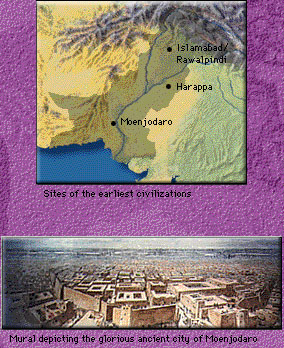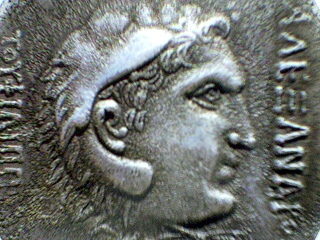|
 Indus Civilization Indus Civilization
The Indus Valley Civilization was at its peak from the 3rd till the middle of the 2nd millennium BC. Discovered in 1922, Moenjodaro (in Sindh province) was once a metropolis of great importance, forming part of the Indus Valley Civilization with Harrappa (discovered in 1923 in the southern Punjab), Kot Diji (Sindh) and recently discovered Mehr Garh (Balochistan).
Moenjodaro is considered as one of the most spectacular ancient cities of the World. It had mud and baked bricks’ buildings, an elaborate covered drainage system, a large state granary, a spacious pillared hall, a College of Priests, a palace and a citadel. Harrappa, another major city of the Indus Valley Civilization, was surrounded by a massive brick wall fortification.
 Other features and plan of the city were similar to that of Moenjodaro. The Kot Diji culture is marked by well-made pottery and houses built of mud-bricks and stone foundations. Mehr Garh, the oldest Civilization (7,000 B.C), remains of which were found in the district Kachhi of Balochistan recently, was the pioneer of the Indus Valley Civilization. The evidence of crop cultivation, animal husbandry and human settlements have been found here. The inhabitant of Mehr Garh were living in mud-brick houses and learned to make pottery around 6,000 B.C. Other features and plan of the city were similar to that of Moenjodaro. The Kot Diji culture is marked by well-made pottery and houses built of mud-bricks and stone foundations. Mehr Garh, the oldest Civilization (7,000 B.C), remains of which were found in the district Kachhi of Balochistan recently, was the pioneer of the Indus Valley Civilization. The evidence of crop cultivation, animal husbandry and human settlements have been found here. The inhabitant of Mehr Garh were living in mud-brick houses and learned to make pottery around 6,000 B.C.
Gandhara Civilization
 Gandhara region had once been the hallowed centre of Buddhism, the cradle of the world famous Gandhara sculpture, culture, art and learning. The archaeological remains found in Taxila, Peshawar, Charsadda, Takht Bhai, Swat and rock carvings along the ancient Silk Road (KKH) have well recorded the history of Gandhara. Lying in Haro river valley near Islamabad, Taxila, the main centre of Gandhara, is over 3,000 years old. Taxila has attracted the attention of the great conqueror, Alexander in 327 B.C., when it was a province of the powerful Achaemenian Empire. It later came under the Maurian dynasty and reached a remarkable matured level of development under the great Ashoka. Then appeared the Indo-Greek descendants of Alexander’s warriors and finally came the most creative period of Gandhara. Gandhara region had once been the hallowed centre of Buddhism, the cradle of the world famous Gandhara sculpture, culture, art and learning. The archaeological remains found in Taxila, Peshawar, Charsadda, Takht Bhai, Swat and rock carvings along the ancient Silk Road (KKH) have well recorded the history of Gandhara. Lying in Haro river valley near Islamabad, Taxila, the main centre of Gandhara, is over 3,000 years old. Taxila has attracted the attention of the great conqueror, Alexander in 327 B.C., when it was a province of the powerful Achaemenian Empire. It later came under the Maurian dynasty and reached a remarkable matured level of development under the great Ashoka. Then appeared the Indo-Greek descendants of Alexander’s warriors and finally came the most creative period of Gandhara.
 The Kushan dynasty was established in about 50 AD. During the next 200 years, Taxila, Peshawar and Swat became a renowned centre of learning philosophy, art and trade. Pilgrims and travellers were attracted to Gandhara from as far as China and Greece. In 5th century AD, the White Huns snuffed out the last of the successive civilizations that held unbroken sway in this region for several centuries. The Kushan dynasty was established in about 50 AD. During the next 200 years, Taxila, Peshawar and Swat became a renowned centre of learning philosophy, art and trade. Pilgrims and travellers were attracted to Gandhara from as far as China and Greece. In 5th century AD, the White Huns snuffed out the last of the successive civilizations that held unbroken sway in this region for several centuries.
Mughal Heritage
 Pakistan is a treasure-house of Muslim architecture. Lahore, the cultural hub of Pakistan, is situated along the bank of Ravi river. The city has witnessed the rise and fall of many dynasties like Ghaznavis (1021-1186 AD), Ghoris (1186-1202 AD) and Slaves (1206-1524 AD) before arrival of the Mughals. The city was conquered by Babur of Ferghana (situated in Uzbekistan), the founder of the Mughal dynasty (1524-1764 AD). All the important monuments like the Royal Fort and the Mosque, Wazir Khan’s Mosque, Tombs of Jehangir, Asaf Khan, Noor Jehan and the Shalimar Gardens, Hiran Minar etc., were constructed during this period. On the other hand, the shrines, mosques and forts located in and around Multan and Bahawalpur are the master pieces of the early Muslim architecture. Some important buildings are; Forts at Multan and Derawar (Bahawalpur), shrines of Shaikh Bahauddin Zakaria, Shah Rukan-e-Alam, Hazrat Shams Tabrez at Multan and Tomb of Bibi Jiwandi at Uchh Sharif near Bahawalpur. The tombs at Chaukundi, 27 km out of Karachi, the remains at Banbhore (64 km from Karachi) and the necropolis of a million graves scattered over an area of 10 sq. km on Makli Hills near Thatta together with the Shahjehan Mosque of Thatta, are exquisite specimens of Muslim architecture, stone carving and glazed tile decorations. Pakistan is a treasure-house of Muslim architecture. Lahore, the cultural hub of Pakistan, is situated along the bank of Ravi river. The city has witnessed the rise and fall of many dynasties like Ghaznavis (1021-1186 AD), Ghoris (1186-1202 AD) and Slaves (1206-1524 AD) before arrival of the Mughals. The city was conquered by Babur of Ferghana (situated in Uzbekistan), the founder of the Mughal dynasty (1524-1764 AD). All the important monuments like the Royal Fort and the Mosque, Wazir Khan’s Mosque, Tombs of Jehangir, Asaf Khan, Noor Jehan and the Shalimar Gardens, Hiran Minar etc., were constructed during this period. On the other hand, the shrines, mosques and forts located in and around Multan and Bahawalpur are the master pieces of the early Muslim architecture. Some important buildings are; Forts at Multan and Derawar (Bahawalpur), shrines of Shaikh Bahauddin Zakaria, Shah Rukan-e-Alam, Hazrat Shams Tabrez at Multan and Tomb of Bibi Jiwandi at Uchh Sharif near Bahawalpur. The tombs at Chaukundi, 27 km out of Karachi, the remains at Banbhore (64 km from Karachi) and the necropolis of a million graves scattered over an area of 10 sq. km on Makli Hills near Thatta together with the Shahjehan Mosque of Thatta, are exquisite specimens of Muslim architecture, stone carving and glazed tile decorations.
The Silk Route
 For centuries, the Silk Route remained the main trading route between the South Asia and the Central Asia. After the construction of the Karakoram Highway (KKH) in 1982 along the same alignment, joining Pakistan with Chinese Muslim autonomous region of Xinjiang, the ancient trade link has been revived. The KKH For centuries, the Silk Route remained the main trading route between the South Asia and the Central Asia. After the construction of the Karakoram Highway (KKH) in 1982 along the same alignment, joining Pakistan with Chinese Muslim autonomous region of Xinjiang, the ancient trade link has been revived. The KKH  has provided a great opportunity for international travellers to explore the un-spoilt natural beauty, unique culture and ancient traditions of the Northern Pakistan together with the other Silk Road countries like China, Kirgizstan, Tajikistan, Kazakastan and Uzbekistan. has provided a great opportunity for international travellers to explore the un-spoilt natural beauty, unique culture and ancient traditions of the Northern Pakistan together with the other Silk Road countries like China, Kirgizstan, Tajikistan, Kazakastan and Uzbekistan.
|

